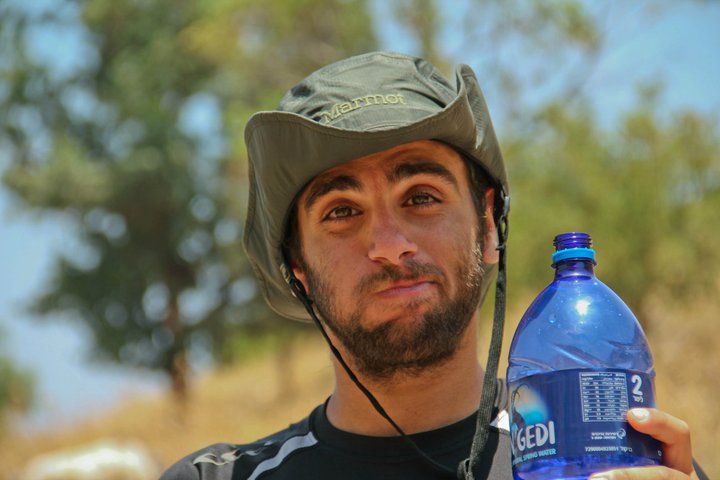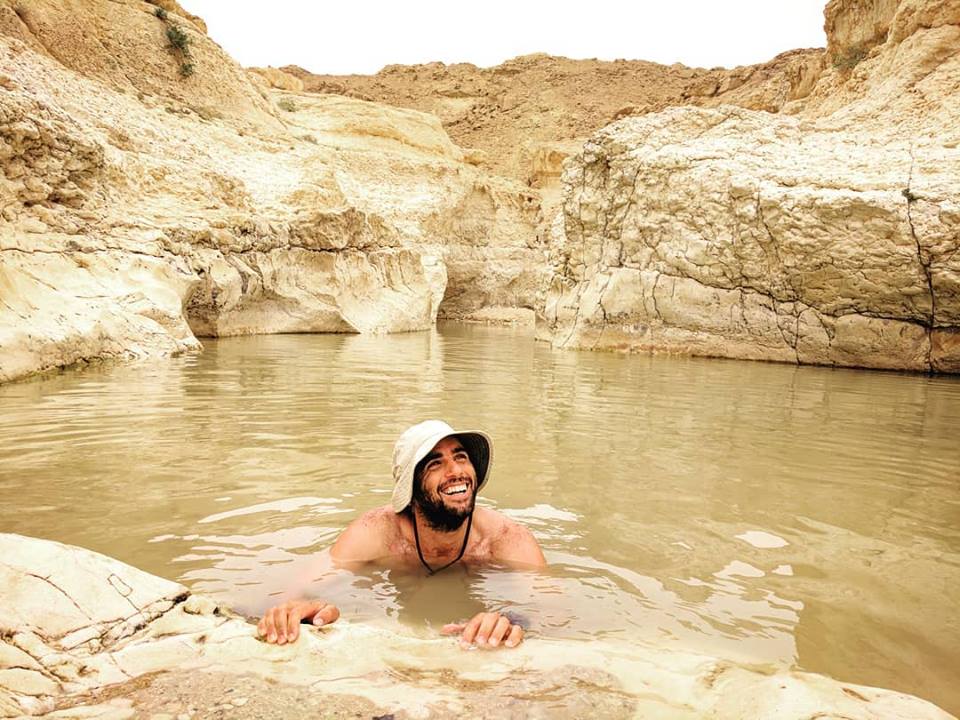Water caches for the Israel National Trail are relevant only to segments of the trail in the southern region of Israel (between Arad and Eilat). You’ll need greater quantities of water in the south than in the north, and the biggest challenge is finding water sources in the south to replenish your water supply. So if want to explore the southern segments of the trail, do your homework properly and well in advance. Below are details and information on how it works and what you need to do. Courtesy of Yanir Bamidbar.
Israel national trail Water Caches & Food Supply – Key Notes:
- Finding water sources gets tricky from the town of Arad and southwards. From here on south, you’ll need to drink more and use 5-6 liters per day.
- Drinking water constitutes the majority of your water supply.
- Other water requirements include cooking, washing up, coffee prep and basic hygiene.
- There’s no way to do the southern segments of the trail without water caches.
- The southern region is relatively desolate, with fewer inhabitants and less infrastructure. So it’s harder to improvise, and demands contingency plans made well in advance.
- The term “water cache” refers not only to water buried or hidden in the ground or rock crevice. Trail Angels who can drop off extra water along the way, or a rendezvous with family or friends at a certain point along the way, also count as water caches.
- Smart planning includes a combination of the various sources (water cache point, Trail Angel drop-off, family rendezvous, etc.).
- If you plan to stash your own water caches along the route, take into account that you might need a 4X4 vehicle to get there.
- For Download: maps of existing water cache locations (source: Society for the Protection of Nature in Israel)
How to Plan Water Caching:
First, Open a map and work out exactly on which days of your route you’ll have no access to water sources (no water sources means no town or village within walking distance nor running water at your campsite).
Sometimes, you can take a short detour to a nearby town or village or refill your water bottles from a tap near your campsite, depending on how far off course you need to stray to access the water source. It’s best to do this on the way to your campsite after you’ve completed your walking segment for the day and again the following morning when you’re ready to start walking.
Places where you won’t be able to refill your water supply for the following day are the points you should mark for a water cache. You can refer to the list below.
You can also cache food at certain water cache points (not at every point, but rather one food cache every 4 to 5 days).
Next you’ll need to decide if you want to cache the water yourself (today, less popular and a waste of time if you ask me). it’s easier to pay for Trail Angles to stock existing cache locations with water or schedule to meet with friends or family along the route. especially if you are just visiting here.
In both cases make sure that:
- You take a photo of the location and exact spot
- You write a route description with detailed directions on how to get to the cache point
- You print out both the photo and description or print out a screenshot from your smartphone or GPS
Why? This is because you could be faced with a dead phone battery and won’t have access to the description you’ve saved on your phone.
The Lowdown on Paid Cache Services:
If you decide to pay for caching, call the Trail Angel hotline way in advance. Most of the service providers in this area know all the campsites with cache locations along the Israel National Trail. Trail Angels are generally kind-hearted Israelis with a jeep and an outdoorsy occupation or propensity for nature trails.
Here’s how it works:
Once in a while these Trail Angels cache large quantities of water (usually six-packs of 1.5 liter bottles) at a particular point, especially at campsites with remote or difficult access.
When you inquire about a water cache at a certain point, a service provider will be able to tell you if and how much water is there. They’ll ask you to report back to them on your decision, even if you decide not to cash in on the cache (so they can keep track).
If you decide to avail yourself of their services, you’ll need to wire them payment and send them a transfer confirmation.
As soon as you transfer payment, you’ll receive photos and directions to the cache location (again, remember to write down the directions on paper and don’t rely on your phone for directions on WhatsApp).
If no cache point exists at the location you need it – which means that a service provider will have to make a special trip to drop off water there – the bulk of the expense comes from the need for a 4X4.
How much does it cost?
For 6 liters at an existing cache location with no need for a special trip: 70-120 NIS per person (in the case of an already stocked water cache)
A special trip to drop off water depends on the distance and effort entailed. The price usually ranges from 350 to 800 NIS. There’s no limit to the amount of water you can order.
Water cache points & campsites for backpacking the INT north to south:
(*remember, Water caches are not required north of Arad).
Be’er Efe is accessible by regular vehicle (no running water).
Meizad Tamar is accessible by regular vehicle (no running water).
Machtesh Katan-Maaleh Eli is accessible by regular vehicle (with running water).
Oron Facility is accessible by regular vehicle (with running water).
MaDor-Oron is accessible only by 4X4 vehicles (no running water).
Hod Akev is accessible only by 4X4 vehicles (no running water) or take a detour 5 km off route and walk to Midreshet Ben Gurion where there’s water and a grocery store.
Nachal Chava is accessible only by 4X4 vehicles (no running water).
Har Saharonim-Nachal Gvanim is accessible by regular vehicle (no running water).
Nachal Nikrot-Gev Cholit is accessible only by 4X4 vehicles (no running water).
Nachal Barak is accessible by regular vehicle (no running water).
Nachal Tzichor (2 km west of Tzichor Junction) is accessible by regular vehicle (no running water).
Be’er Malchan is accessible only by 4X4 vehicles (no running water).
Nachal Mangan-Sasgon is accessible by regular vehicle but difficult to reach (no running water); Further along the Israel National Trail and 2 km from this campsite gets you to the entrance of Timna Park where there’s running water for and hikers a good place to lay your head
Nachal Racham-Etek is accessible only by 4X4 vehicles (no running water). I recommend taking a detour to Beer Ora, about 3 km off route where you’ll find both water and a grocery store.
Shacharut Kenyon is accessible by regular vehicle (no running water).
Har Yehoram is accessible by regular vehicle (no running water).
Water cache points & campsites for backpacking the INT south to north:
Har Yehoram is accessible by regular vehicle (no running water).
Shacharut Kenyon is accessible by regular vehicle (no running water).
Nachal Racham-Etek is accessible only by 4X4 vehicles (no running water). I recommend taking a detour to Beer Ora, about 3 km off route where you’ll find both water and a grocery store.
Nachal Mangan-Sasgon is accessible by regular vehicle but difficult to reach (no running water); Further along the Israel National Trail and 2 km from this campsite gets you to the entrance of Timna Park where there’s running water for hikers and a good place to lay your head.
Be’er Malchan is accessible only by 4X4 vehicles (no running water).
Nachal Tzichor (2 km west of Tzichor Junction) is accessible by regular vehicle (no running water).
Nachal Barak is accessible by regular vehicle (no running water).
Nachal Nikrot-Gev Cholit is accessible only by 4X4 vehicles (no running water).
Har Saharonim-Nachal Gvanim is accessible by regular vehicle (no running water).
Nachal Chava is accessible only by 4X4 vehicles (no running water).
Hod Akev is accessible only by 4X4 vehicles (no running water) or take a detour 5 km off route and walk to Midreshet Ben Gurion where there’s water and a grocery store.
Nachal Mador-Derech Oron is accessible only by 4X4 vehicles (no running water).
Oron Facility is accessible by regular vehicle (with running water).
Machtesh Katan is accessible by regular vehicle (with running water).
Meizad Tamar is accessible by regular vehicle (no running water).
Be’er Efe is accessible by regular vehicle (no running water).
***
Article courtesy of Yanir Yagel.
Yanir offers water cache, drop-off and emergency rescue services on the Israel National Trail, as well as insured water caches in the event of theft. Find Yanir Bamidbar here or in Facebook or call him directly at +972-54-2461066.


